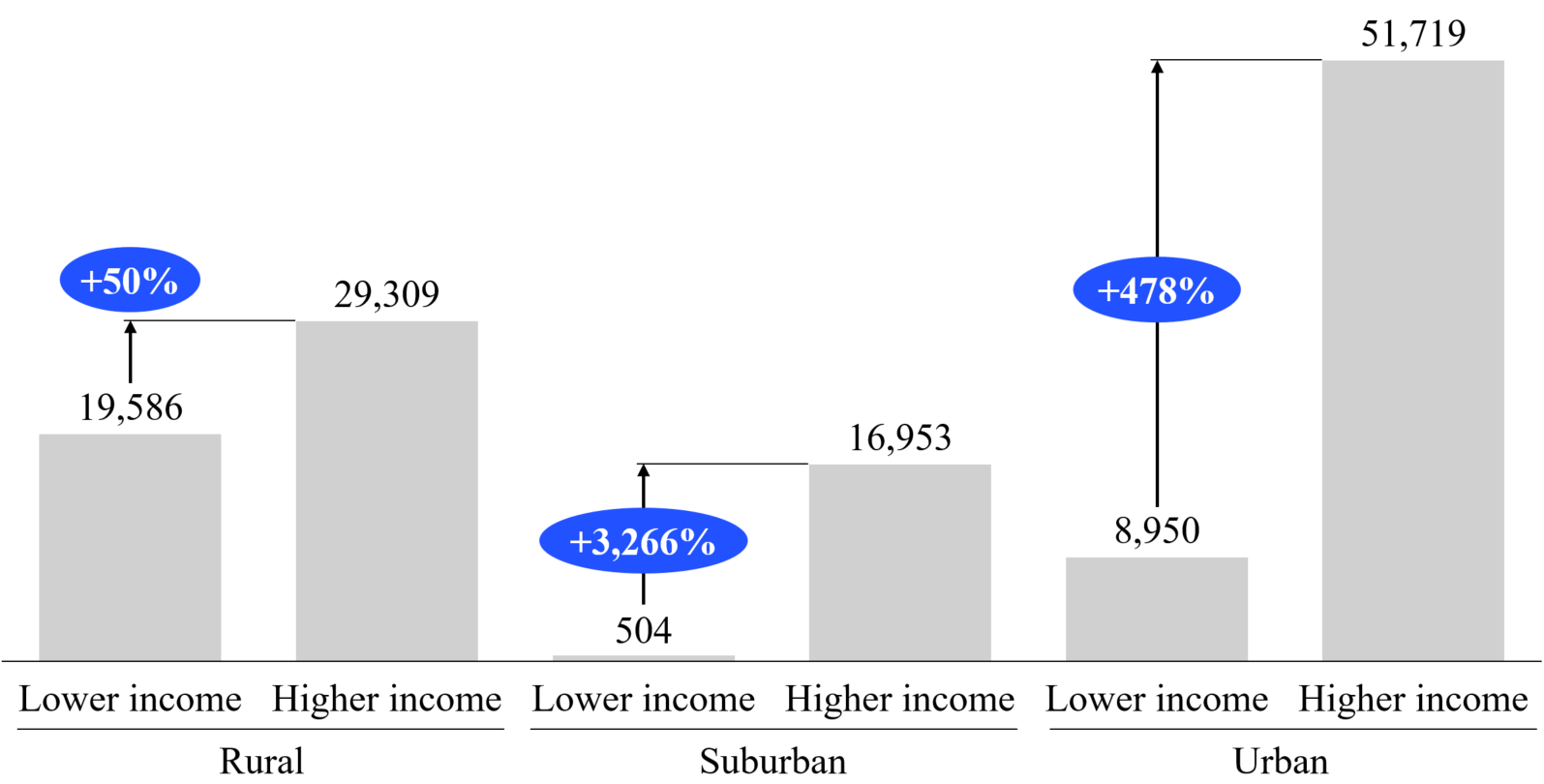CEEPR Working Paper
2023-13, July 2023
Sarah A. Steinbach and Maximilian J. Blaschke
With tightening carbon emission regulations in the transportation sector, more and more consumers are switching to electric vehicles (EVs). However, charging a high number of EVs poses challenges to the distribution grids: Most consumers favor charging their EVs at similar times during the day, especially in the early evening hours. This parallel charging of multiple EVs could lead to significant load peaks causing overloads within the grids (Clement-Nyns et al. 2010; Lopes et al. 2011; Muratori 2018). These overloads increase with EV adoption and depend on the EV model choice and the applied charging patterns. All these factors may be correlated with socio-economic attributes, especially household income (see, e.g., Xue et al. 2021; Sovacool et al. 2019; Kelly et al. 2012; Lee and Brown 2021; Gauglitz et al. 2020). Therefore, grid operators may have to over-proportionally enhance the grid infrastructure in areas with many high-income households. Our paper investigates how the necessary grid reinforcement costs differ between lower and higher-income neighborhoods. From these calculations, we quantify the over-proportional grid reinforcement cost impact of higher-income EV users, its potential to cause energy inequity and derive policy recommendations accordingly.
We simulate electricity usage for two neighborhood types: below-average (lower) and above-average (higher) income. For these two neighborhood types, we assign respective EVs considering adoption and model choices and fit the corresponding mobility behavior. We use representative distribution grids in urban, suburban, and rural settings to account for the differing structure and load capacity. After allocating the electric vehicles amongst the grid nodes, the simulations check each setting for overloads and derive the grid reinforcement cost asymmetry between the two neighborhood types. To consider the most challenging season for electricity usage, we perform the simulation over a week in December.
Based on simulated load profiles, we investigate the grid overloads occurring for below- and above-average-income rural, suburban, and urban neighborhoods. This overload analysis is relevant for grid planning, as it displays which neighborhoods require prioritization. In all area types, higher-income neighborhoods would experience significantly more grid overloads, putting these neighborhoods higher on the grid operators’ agenda for grid reinforcements. As the number of overloads and hence the probability for a blackout differ significantly between lower and higher-income neighborhoods, the importance of including socio-economic factors such as income in grid planning models becomes apparent.
Next, we derive the related grid reinforcement costs to mitigate the overloads previously outlined and stabilize the grid. The average reinforcement costs to be expected are illustrated in Figure 1 shown below.

Figure 1: Average simulated grid reinforcement costs (in €) in December.
We see 50% additional grid reinforcement costs for higher-income neighborhoods in the rural, 3,266% in the suburban, and 478% in the urban grid compared to lower-income neighborhoods. The reinforcement costs in the rural grid do not differ that much as this grid offers the least resilience. An upgrade of its bottleneck, the transformers, becomes inevitable even for lower EV charging loads.
The asymmetries in grid reinforcement cost illustrate the necessity for grid operators to include socio-economic factors such as income in their grid planning models to represent future grid costs adequately. When extrapolating our findings to the around 119 million residential buildings in the EU and accounting for their distribution to rural, suburban, and urban areas, the potential grid cost asymmetry between higher- and lower-income neighborhoods could reach approximately €14 billion.
In order to derive appropriate mitigating policy measures, we further analyze the impact of the underlying drivers for the additional grid reinforcement cost of higher-income neighborhoods. We quantify the standalone impact of differences in EV adoption, model choice, and driving patterns by neighborhood type. If EV adoption were equally distributed over all neighborhoods, the grid reinforcement cost asymmetries would shrink significantly. This effect, however, is partly caused by a related grid cost increase for lower-income neighborhoods. Nonetheless, our results show that even if equal EV adoption levels across income levels could be achieved, significant additional grid reinforcement costs for higher-income neighborhoods prevail, especially for the suburban and urban grids. Driving patterns strongly impact grid cost asymmetry, while the effect of model choice is relatively small. These findings indicate that policymakers may foster EV adoption with all model sizes but focus more on reducing peak-hour charging to mitigate some behavioral effects of higher-income households.
Residential grid reinforcement costs are currently paid for via the consumer electricity price. If grid costs increase, the electricity price inflates for all consumers across neighborhoods. Due to their higher total electricity consumption and related higher electricity costs, higher-income neighborhoods carry more of the grid reinforcement costs in total. However, as they only consume 16%-18% (based on the area type) more electricity than lower-income households, this contribution fails to offset the massive additional grid reinforcement costs caused. Furthermore, grid operators often split grid costs into a base rate in addition to a volumetric (per kWh) component. This base rate is not scaled with regards to consumption and hence further limits the grid cost contribution of higher-income households (Bundesnetzagentur 2020). With household electricity prices at a record high (e.g. 32.63ct/kWh in 2021 in Germany and quickly increasing during the European Energy Crisis in 2022 (Bundesnetzagentur 2022; Statistisches Bundesamt 2022; Guan et al. 2023)), consumers have to expect further across-the-board electricity price increases to cover the additional grid reinforcement. This, however, is inequitable with respect to the principle of fairness according to contribution. As this grid reinforcement cost asymmetry can be traced back to higher-income neighborhoods, equitable cost allocation would require higher-income households to fully bear this cost asymmetry, not affecting the electricity prices of other consumers.
Policymakers should consider alternative electricity pricing models that adjust for maximum electricity loads induced. They could also encourage a dynamic electricity pricing strategy increasing peak-time electricity prices for households. EV adoption greatly impacts the magnitude of the inequitable grid cost allocation. As it is not desirable to reduce overall EV adoption and limit the electrification of mobility, policymakers could reduce the inequity in cost allocation by increasing subsidies for EV adoption in lower-income households, where EV subsidies have shown the strongest impact on EV adoption (Sheldon et al. 2023). However, households that cannot afford an electric vehicle will not benefit from any of such actions but still face higher grid costs.
We contribute to current research by quantifying grid cost asymmetries with electric vehicle charging, considering socio-economic factors. With this contribution, we illustrate the importance for researchers and grid operators to include socio-economic factors in their simulations and support policymakers in factoring energy equity issues into future electricity pricing designs and subsidy schemes. This article provides new insights into the cost of the sustainable mobility transition and sheds light on the intensifying energy inequity.




